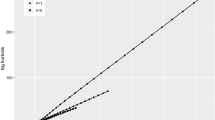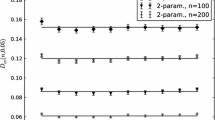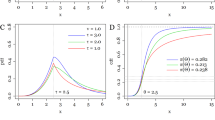Abstract
The g-and-h distribution is a flexible model for skewed and/or leptokurtic data, which has been shown to be especially effective in actuarial analytics and risk management. Since in these fields data are often recorded only above a certain threshold, we introduce a left-truncated g-and-h distribution. Given the lack of an explicit density, we estimate the parameters via an Approximate Maximum Likelihood approach that uses the empirical characteristic function as summary statistics. Simulation results and an application to fire insurance losses suggest that the method works well and that the explicit consideration of truncation is strongly preferable with respect the use of the non-truncated g-and-h distribution.








Similar content being viewed by others
References
Beaumont MA (2010) Approximate Bayesian computation in evolution and ecology. Annu Rev Ecol Evol Syst 41:379–406
Bee M (2006) Estimating the parameters in the loss distribution approach: how can we deal with truncated data? In: Davis E (ed) The advanced measurement approach to operational risk. Risk Books, London, pp 123–144
Bee M, Hambuckers J, Santi F, Trapin L (2021) Testing a parameter restriction on the boundary for the g-and-h distribution: a simulated approach. Comput Stat 36:2177–2200
Bee M, Hambuckers J, Trapin L (2019) Estimating value-at-risk for the g-and-h distribution: an indirect inference approach. Quant Finan 19(8):1255–1266
Bee M, Hambuckers J, Trapin L (2021) Estimating large losses in insurance analytics and operational risk using the g-and-h distribution. Quant Finan 21(7):1207–1221
Bee M, Trapin L (2016) A simple approach to the estimation of Tukeys gh distribution. J Stat Comput Simul 86(16):3287–3302
Bee M, Trapin L (2018) A characteristic function-based approach to approximate maximum likelihood estimation. Commun Stat Theory Methods 47(13):3138–3160
Carrasco M, Florens J (2002) Efficient GMM estimation using the empirical characteristic function. Technical report, Department of Economics, University of Rochester
Cruz M, Peters G, Shevchenko P (2015) Fundamental aspects of operational risk and insurance analytics: a handbook of operational risk. Wiley, Hoboken
Degen M, Embrechts P, Lambrigger DD (2007) The quantitative modeling of operational risk: between g-and-h and EVT. Astin Bull 37(2):265–291
Dutta KK, Perry J (2006) A tale of tails: an empirical analysis of loss distribution models for estimating operational risk capital. Technical Report 06–13, Federal Reserve Bank of Boston
Embrechts P, Klüppelberg C, Mikosch T (1997) Modelling extremal events for insurance and finance. Springer, New York
Feuerverger A, Mureika RA (1977) The empirical characteristic function and its applications. Ann Stat 5:88–97
Garcia R, Renault E, Veredas D (2011) Estimation of stable distributions by indirect inference. J Econ 161(2):325–337
Hoaglin DC (1985) Summarizing shape numerically: the g-and-h distributions, chapter 11, pp 461–513. Wiley
Kleiber C, Kotz S (2003) Statistical size distributions in economics and actuarial sciences. Wiley, Hoboken
Klugman SA, Panjer HH, Willmot GE (2004) Loss models: from data to decisions, 2nd edn. Wiley, Hoboken
Koenker R (2005) Quantile regression. Cambridge University Press, Cambridge
McNeil A, Frey R, Embrechts P (2015) Quantitative risk management: concepts, techniques, tools, 2nd edn. Princeton University Press, Princeton
Nadarajah S, Kotz S (2006) R programs for computing truncated distributions. J Stat Softw 16
Panjer HH (2006) Operational risk modeling analytics. Wiley, Hoboken
Peters GW, Chen WY, Gerlach RH (2016) Estimating quantile families of loss distributions for non-life insurance modelling via L-moments. Risks 4(2):14
Prangle D (2015) Summary statistics. In: Sisson SA, Fan Y, Beaumont M (eds) Handbook of approximate Bayesian computation. Chapman and Hall, London, pp 125–152
Rubio FJ, Johansen AM (2013) A simple approach to maximum intractable likelihood estimation. Elect J Stat 7:1632–1654
Xu D, Knight J (2010) Continuous empirical characteristic function estimation of mixtures of normal parameters. Economet Rev 30(1):25–50
Acknowledgements
We would like to thank two anonymous reviewers whose valuable comments considerably improved an earlier version of the paper.
Author information
Authors and Affiliations
Corresponding author
Additional information
Publisher's Note
Springer Nature remains neutral with regard to jurisdictional claims in published maps and institutional affiliations.
Rights and permissions
About this article
Cite this article
Bee, M. The truncated g-and-h distribution: estimation and application to loss modeling. Comput Stat 37, 1771–1794 (2022). https://doi.org/10.1007/s00180-021-01179-z
Received:
Accepted:
Published:
Issue Date:
DOI: https://doi.org/10.1007/s00180-021-01179-z




